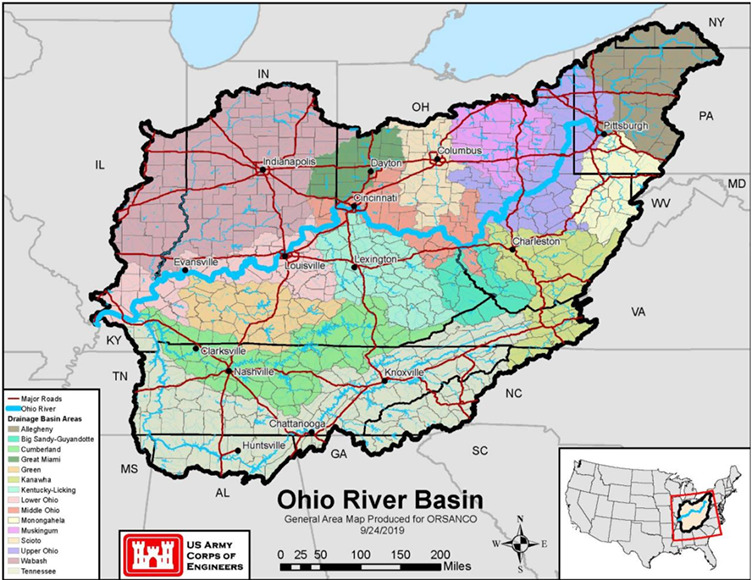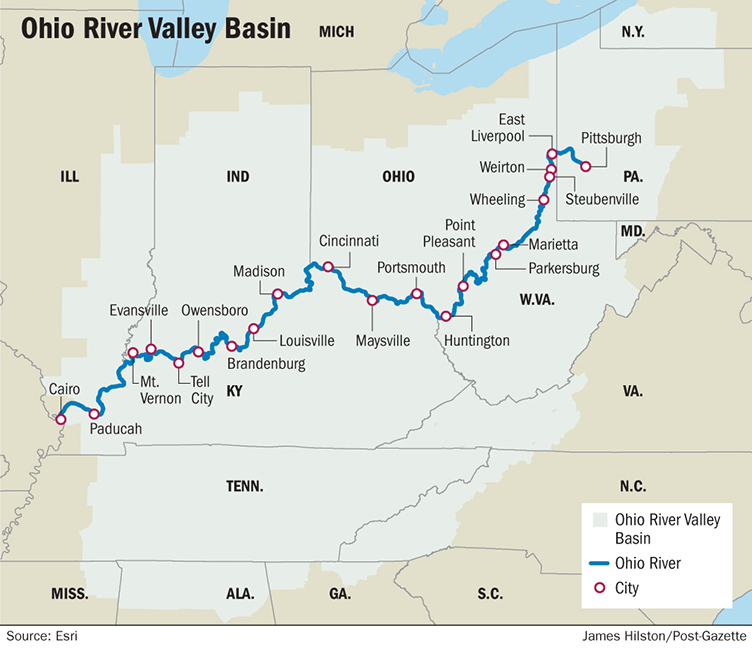Over the last two articles, I introduced you to the Ohio River Basin Alliance (ORBA) and presented ORBA’s strategies to make sure we continue to have abundant clean water. In this article, I’m going to discuss ORBA’s plans to maintain the basin’s healthy and productive ecosystems.

First, let’s talk about how diverse our ecosystems are in the Ohio River Basin. Did you know the Ohio River and its tributaries are home to 164 species of fish and over 100 species of mussels? The Ohio River Basin is very large and covers an area of 200,000 square miles with about 7,000 miles of waterfront along the Ohio River and its main tributaries. The Basin is nationally and internationally renowned for its diversity of ecoregions that distinguishes it from other basins within the United States. As shown on the map below, portions of 16 different ecoregions are found within the Basin making it one of the most diverse and productive regions in the nation. In fact, the Green, Tennessee, and Cumberland River sub-basins are among the richest ecological regions in the world based on species diversity.

Although rich in diversity, human activity has led to the loss of wildlife habitat that negatively impacts native wildlife populations. Of the 127 mussel species once found in the Ohio River, 11 are now extinct and 46 others are threatened, endangered or a species of concern.
Also, unfortunately, non-native invasive species are moving into the basin every year and threatening our native species. Invasive species already present in the basin include Asian carp, zebra mussels, emerald ash borer, and kudzu. These invasive species are capable of outcompeting native species for resources, altering ecosystem functions, and causing disease, and remarkably their impacts cost billions of dollars to the nation’s economy each year. Typically, invasive species often grow faster, disperse over larger areas, and have few natural predators so they can outcompete native species, reduce biodiversity, degrade water quality, and negatively affect our recreational, commercial, and agricultural activities.
The condition of our soil also has a profound impact on our ecosystems as well as water quality. Presently, our soils along with their nutrients are being eroded from farmlands at a greater rate than it can be replenished. Improving the health of our basin’s soil for water infiltration is an effective way to decrease runoff and improve moisture content and nutrient retention for healthy crops.
One of my last projects with the U.S. Army Corps of Engineers was a pilot study that evaluated the impacts of climate change on the Ohio River Basin. According to the climate change models conducted during the study by the National Weather Service, the average temperature is expected to rise a half-degree per decade from 2011-2040 and a full degree from 2041 to 2099. This rise in temperature causes changes in precipitation, which of course, impacts flows. The changing patterns in our precipitation will create more challenges for not only maintaining our ecosystems but also for agriculture, industries, and communities that need reliable water sources.
So How Do We Maintain Healthy and Productive Ecosystems?
As part of the strategic plan for the Ohio River Basin, there are three main objectives for maintaining and enhancing our ecosystems.
Objective 1: By 2022, basin states, conservation organizations, the USEPA, ORSANCO, and other stakeholders will work together to develop a plan to improve the basin’s ecosystem through the identification of at-risk ecosystems and the threats to them such as acid mine drainage and emerging toxic contamination.
Strategic actions that ORBA stakeholders plan to take to meet this objective would be to facilitate coordination among The Nature Conservancy, the US Fish and Wildlife Service, the National Wildlife Federation, the Ohio River Basin Fish Habitat Partnership, the Southeast Aquatic Resources Partnership, and other stakeholders to develop and restore the basin’s aquatic ecosystem.
Objective 2: By 2025, secure funding to initiate a federal geographic program to restore the basin that meets the needs of the states, the USEPA, ORSANCO, and other stakeholders.
Basin stakeholders would establish an Ohio River Basin Restoration Initiative using guidance from similar restoration initiatives such as the Chesapeake Bay Restoration Program, the Columbia River Restoration Program, and the Great Lakes Restoration Initiative. They would also work to restore floodplains and protect existing high-quality habitats and native aquatic populations. In addition, they would expand upon the Natural Resource Conservation Service’s existing Mississippi River Basin Healthy Watersheds Initiative to pursue a healthy soil initiative to protect farmlands and improve erosion control, water retention, and fish and wildlife habitat.
Objective 3: Implement strategies to eradicate, control, and manage invasive species utilizing sound scientific data and effective control methods. Also develop and implement education and outreach programs to increase the understanding of the negative impacts of invasive species.
ORBA will advocate for existing organizations like the Aquatic Nuisance Species Task Force to develop and implement a basin-specific program to study, monitor, and control invasive species. It will also advocate for basin funding in 2021 for the Asian Carp National Plan.
Next time we’ll look at the 3rd goal – performing research and improving education so the public and decision-makers can make informed decisions. If you’d like to join ORBA, contact Dr. Harry Stone at hstone@orsanco.org.


